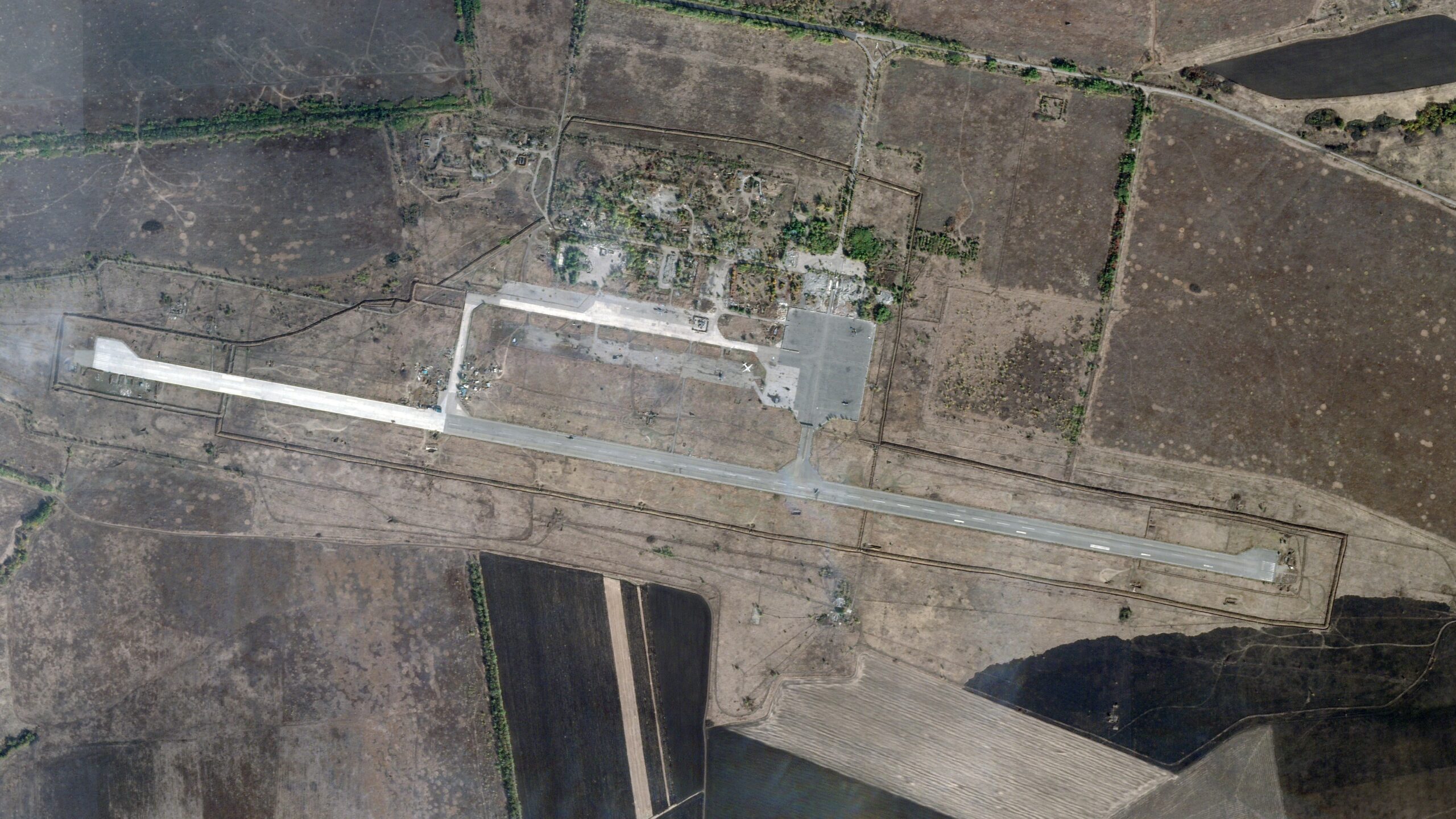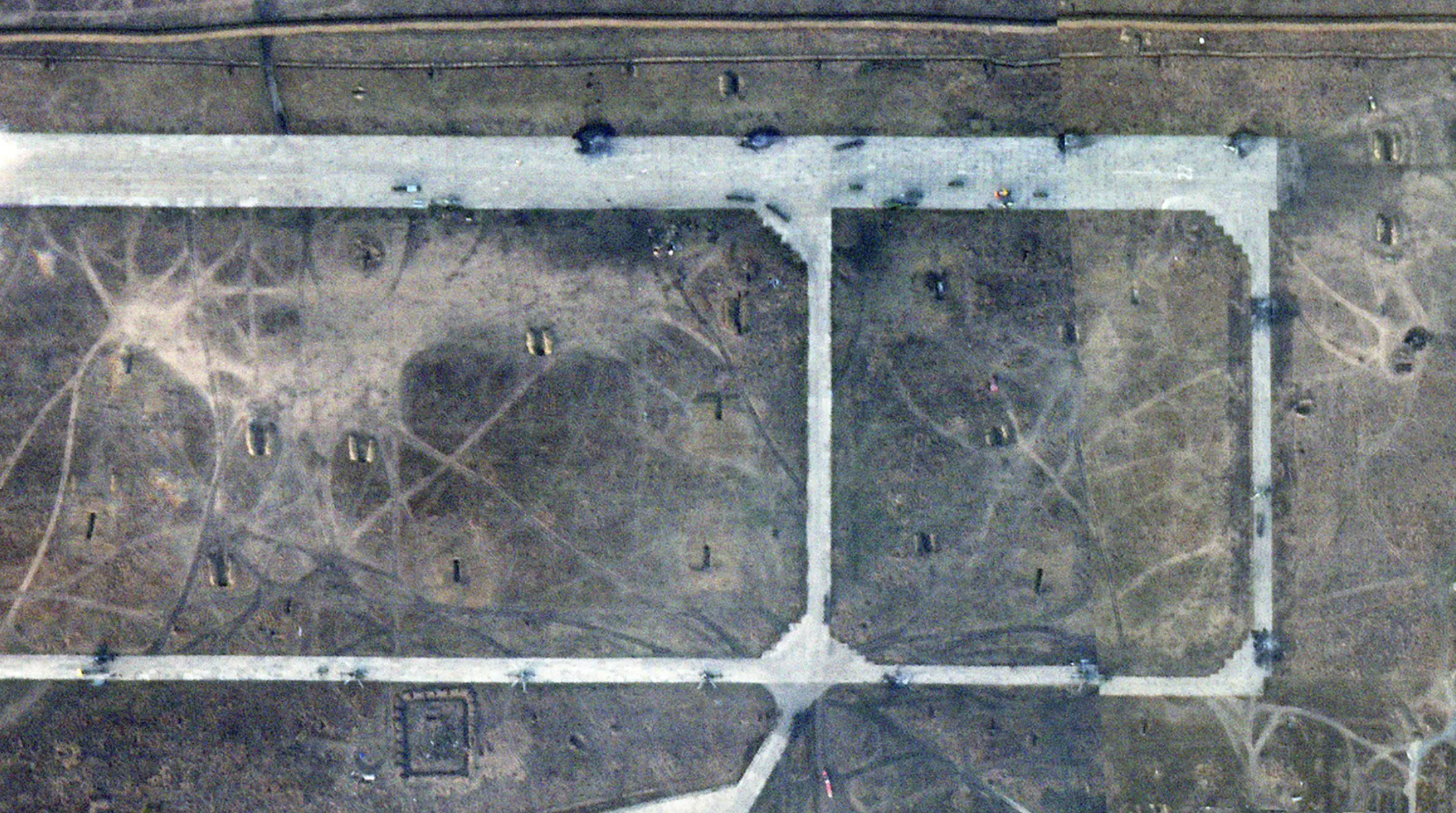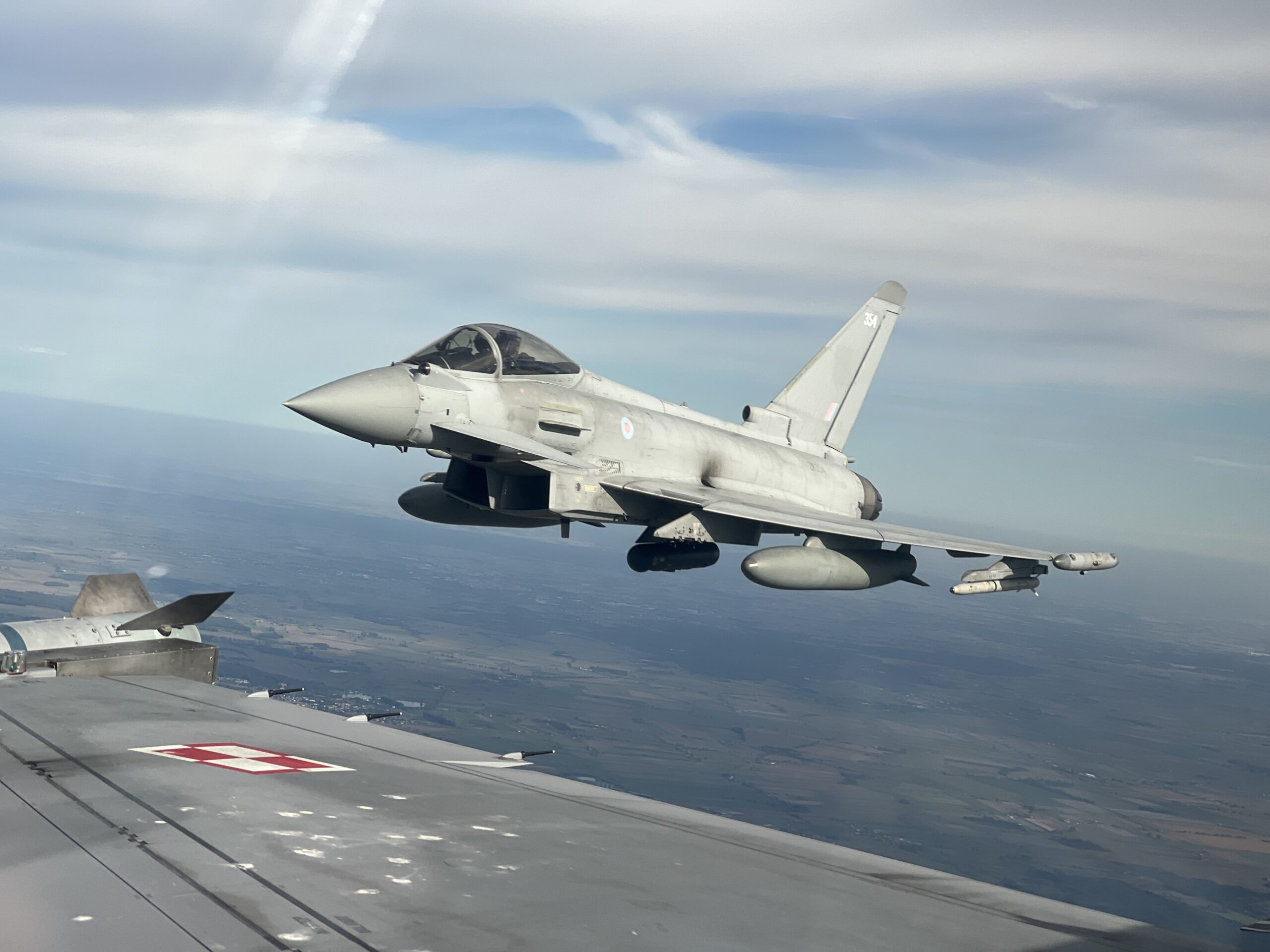The missile strikes on Russian airbases in occupied areas of Ukraine earlier this week could prompt Moscow to push its operational bases and command-and-control sites further back from the front lines, something that The War Zone predicted in detail. This is now the assessment of the U.K. Ministry of Defense and it follows satellite imagery from Berdyansk and Luhansk airfields that reveal multiple damaged or destroyed helicopters.
You can read our previous coverage of those missile strikes, which saw the first confirmed use of the Army Tactical Missile System (ATACMS) in Ukrainian hands, here.

The strikes on Tuesday were directed against airbases at Berdyansk, in the Zaporizhzhia region, in the southeast of Ukraine, and at Luhansk, in the Donbas region of eastern Ukraine. Both are important hubs for Russian military helicopter operations in Ukraine.
The following satellite image, showing Berdyansk airbase, suggests that Russia has already begun to move some helicopters from here, in the wake of the ATACMS strike:
The missiles used in the strikes were soon confirmed to be the initial variant of ATACMS, known variously as the MGM-140A, the M39, and the Block I. The payload of this missile comprises 950 relatively small M74 submunitions. These submunitions can be dispersed over a wide area and, as we stated months before these attacks took place, the cluster-warhead version of ATACMS is an ideal weapon for use against airfields packed with aircraft — among other targets.
A photo has also recently emerged that purports to show damage to a Russian Aerospace Forces Ka-52 Hokum attack helicopter at Berdyansk. The Ka-52 is a type that has been very much at the forefront of recent operations but has sustained numerous losses in the process. While the overall level of damage to this example is unclear, the holes punched in the fuselage and the cockpit glazing by the ATACMS submunitions are plain to see.
In today’s intelligence briefing, the U.K. Ministry of Defense stated:
“Although the extent of damage is currently unconfirmed, it is likely nine Russian military helicopters at Berdyansk and five at Luhansk were destroyed, with Ukraine claiming to have used the U.S.-provided long-range Army Tactical Missiles [sic] for the first time.”
“Given that Russian fixed-wing close air support to date has been extremely poor, Russian defensive lines have become increasingly reliant on rotary-wing support in the face of the Ukrainian offensive. Berdyansk was being used as a primary Forward Operating Base on the southern axis providing both logistics and offensive/defensive capabilities. If confirmed, it is highly likely these losses will have an impact on Russia’s ability both to defend and conduct further offensive activity on this axis. Given the current strain on Russian military production, the confirmed loss of any airframes will be difficult to replace in the short to medium term.”
Russian Aerospace Forces helicopters, including Ka-52 attack helicopters, taking part in nighttime low-level operations as part of the offensive in Ukraine:

“This loss will also likely create additional pressure on Russia’s pilots and airframes, already almost certainly suffering combat exhaustion and maintenance issues due to the unanticipated protracted campaign. There is a realistic possibility this strike will compel Russia to once again relocate its operating bases and command and control nodes farther from the front lines, increasing the burden on logistics chains.”
If this prediction of relocation does come true, it will go a significant way to justifying the supply of ATACMS to Ukraine, which had long sought a reliable means of hitting back at key Russian military targets within Ukrainian borders. The delay in getting ATACMS into Ukrainian hands was, to a significant degree, due to concerns about escalation. So far, however, Russia’s President Vladimir Putin has only responded with words, declaring that the U.S. delivery of the missiles to Ukraine was a “mistake” and that it will only “prolong the agony” for Ukraine.

For Russian commanders, however, the arrival of ATACMS on the battlefield is a real worry, with a wide range of targets now suddenly much more vulnerable to a weapon that is also very hard to defend against. Just as worrying for Russia will be the news that Ukraine now expects to receive a more consistent supply of ATACMS, on top of the smaller number it has received initially. Speaking to a Ukrainian TV channel, Foreign Minister Dmytro Kuleba said that more ATACMS would arrive “on a consistent basis.” He also said he was hopeful that newer and longer-range versions would be included.
It remains to be seen just how Russia deals with the new threat. Above all, it now has to make a calculation about whether it’s better to have key assets and infrastructure, as well as command-and-control sites, located further from the battlefield, where their effectiveness will be reduced, or if they simply accept the risk of ATACMS strikes going forward.
Before getting into the rest of the latest news from Ukraine, The War Zone readers can get caught up with our previous rolling coverage here.
The Latest
The Ukrainian Armed Forces continue to make small gains, as the slow-moving counteroffensive moves ever closer to the frigid winter months. The latest announcement, from military spokesperson Oleksandr Stupun, concerns a gain of 400 meters (437 yards) to the southwest of Verbove in the country’s southern Zaporizhzhia region. Progress here has been limited by extensive Russian minefields, among other heavily fortified defenses, Stupun said.
Meanwhile, the troubled Russian offensive aimed at the town of Avdiivka, north of the city of Donetsk, continues to run into problems. Earlier this week, one of Kyiv’s top commanders declared that the Russian offensive — one of its biggest in months — was failing. Now we have video evidence pointing to that, with the following footage showing the dramatic failure of an assault in the direction of Avdiivka.
The video shows a column of vehicles, led by a tank with a mine-roller, come under attack from Ukrainian drones, before — most alarmingly — the tanks tasked with protecting infantry and armored personnel carriers (APCs) abandon their mission. Once those APCs reach a tree line, the troops disembark and quickly get pinned down by Ukrainian fire. The infantry are seen to retreat before being hit by artillery fire, including devastating cluster ammunition.
More drones now, with the latest dramatic imagery captured by a Ukrainian first-person video (FPV) drone, a weapon that has been playing an increasing role on the battlefield. In this footage, published by the Ukrainian Ministry of Defense, an FPV drone is seen entering the window of a Russian position, with troops holed up in an abandoned building, before the warhead detonates.
Not only drones but also artillery is more or less ubiquitous on the battlefields of Ukraine. This is perhaps the reason that this Ukrainian drone operator barely flinches as an artillery shell explodes nearby.
Elsewhere, there have been reports that the Ukrainian Armed Forces have crossed the Dnipro River and captured two villages located 2-3 miles inland. According to accounts from Russian military bloggers, the operation involved four amphibious combat teams from Ukraine’s 35th and 36th Marine Brigades. These launched their crossing from jump-off positions near the right-bank town of Pridnistrovske in the early morning of October 18.
At this stage, it remains unclear if this operation is part of a planned larger offensive, or simply a raiding party or reconnaissance mission. Whatever the case, this is certainly an area worth watching, with a successful crossing of the biggest inland water obstacle in Ukraine potentially being highly significant.
In their latest briefing, the General Staff of the Ukrainian Armed Forces stated that Russia launched 12 missiles and 60 airstrikes against Ukraine yesterday and that there were 53 instances of bombardment by multiple launch rocket systems (MLRS). The General Staff also said that Russia had engaged Ukrainian troops in combat on 90 occasions on the same day.
According to figures from the Ukrainian Armed Forces, Russia lost 1,380 personnel yesterday. It should be noted that this figure cannot currently be independently verified.
Among the weapons employed by Russia, according to the General Staff, were the Iskander-K ground-launched cruise missile, which was used against a civilian target in Mykolaiv, as well as Iranian-designed Shahed drones. Ukraine claimed that most of the Shahed kamikaze drones, which were launched at targets in southern Ukraine, were brought down by local air defenses.
Among the different locations to come under Russian artillery fire in the previous 24 hours were around 150 settlements located in the Chernihiv, Sumy, Kharkiv, Luhansk, Donetsk, Zaporizhzhia, and Kherson regions, the General Staff added.
In Kharkiv, in particular, there were several Russian attacks that are said to have damaged civilian homes and buildings. This was stated on the Telegram messaging app by Oleg Sinegubov, the head of Kharkiv’s regional state administration.
Among the Russian strikes in the Kharkiv region was an incident of shelling against the city of Vovchansk, which injured two and damaged several buildings; a rocket attack on Kupyansk-Vuzloviy that damaged shops but caused no injuries; and an unknown explosion that injured one person in the city of Kharkiv itself. Meanwhile, a Russian missile is said to have come down in the village of Pidlyman, causing some damage, while shelling of the village of Pisky-Radkivski damaged several more buildings.
In the Kherson region, at least one woman was reported killed in a Russian airstrike on Beryslav this morning, according to regional governor Oleksandr Prokudin. The governor said that Russia had launched a guided bomb against the city as well as fired at it using four “anti-aircraft guns.”
“The indomitable people of Berislav remain in their hometown,” Prokudin said. “Their courage is amazing.”
Russian forces reportedly also launched two guided bombs against Novoberislav, also in the Kherson region, although the extent of the damage there was not yet clear.
A United Nations commission of inquiry has found new evidence that Russia committed war crimes in Ukraine, as part of “indiscriminate attacks,” including rape and deportation of children to Russia.
“The commission has found new evidence that Russian authorities have committed violations of international human rights and international humanitarian law, and corresponding crimes, in areas that came under their control in Ukraine,” it said in a report submitted to the U.N. General Assembly. Some of these attacks happened in the cities of Uman and Kherson, but also elsewhere.
“The commission has recently documented attacks that affected civilian objects, such as residential buildings, a railway station, shops, and a warehouse for civilian use, leading to numerous casualties.”
The commission said it had documented cases of rape “with the use of force or psychological coercion,” most of these incidents taking place after perpetrators broke into the victims’ homes. Some of the victims were raped at gunpoint or after threats of killing or causing serious harm to them or their relatives.
As regards the transfer of children from Ukraine to Russia, the commission documented 31 such incidents, in May and “concluded that it was an unlawful deportation and a war crime.”
Russia has consistently denied committing war crimes or targeting civilians in its full-scale invasion of Ukraine.
The recent damage to infrastructure in the Baltic Sea has led to NATO stepping up its presence in the region, including an increase in the number of surveillance flights there.
“The increased measures include additional surveillance and reconnaissance flights. A fleet of four NATO mine-hunters is also being dispatched to the area,” the alliance said in a statement.
Carl-Oskar Bohlin, Sweden’s civil defense minister, said earlier this week that a sub-sea telecommunication cable connecting Sweden and Estonia had been damaged on or around October 8. At the same time, a sub-sea gas pipeline and another telecom cable connecting Finland and Estonia were also damaged.
While Russia has not been directly blamed for these incidents, the Finnish government has said that the damage to the gas pipeline and telecom cable was likely the work of “outside activity” and that it may have been a deliberate act.
This follows an incident last year in which multiple breaches were identified along sections of the Nord Stream 1 and 2 pipelines that run under the Baltic Sea between Russia and Germany. The exact circumstances behind the ruptures remain unknown, but both NATO and the European Union concluded that they were most likely the result of some kind of deliberate attack.

There are reports of Ukrainian resistance forces blowing up a car of Russian soldiers in the Russian-occupied city of Melitopol. According to the city’s mayor-in-exile, Ivan Fedorov, the Russian soldiers had allegedly been looting empty apartments.
“They regularly tracked and looted empty apartments in the city. And at this time, our resistance forces were tracking the occupiers,” Fedorov said. “During another night hunt in the area of Aviamistechka, at the very moment of loading looted goods into the car, an explosion occurred.”
One of the iconic images of the attempted coup launched by the Wagner Group boss Yevgeny Prigozhin back in June was this T-80BV tank, utilized by Wagner forces in the city of Rostov-on-Don.
That same tank has reportedly now re-entered service with a newly formed Russian unit, the 116th Rosgvardiya Operational (or Separate?) Purpose Brigade, according to the below tweet.
Rosgvardiya is the National Guard of the Russian Federation, responsible for internal military forces.
Elsewhere in Russia, it seems that the military continues to rely upon older weapons, in some categories, at least, either because they’ve simply never given them up or because they’ve had to tap into older stocks to make good losses in the war in Ukraine.
Among the latest examples of this kind is this RPD 7.62mm belt-fed light machine gun, seen in a report from the TASS news agency, showing Russian troops training. The RPD is a design that’s often described as the precursor of modern squad automatic weapons. Work on the RPD began as long ago as 1943 and it was adopted for service in 1948, with large deliveries following in the early 1950s.
That is all for now. This story will be updated when there’s more news to report about Ukraine.
Contact the author: thomas@thedrive.com
